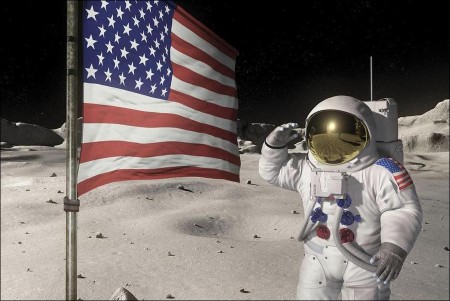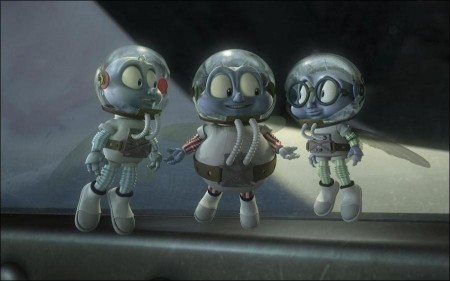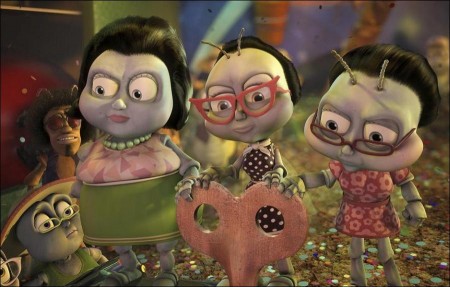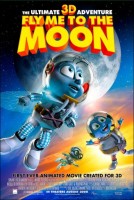“It took a monkey to get man into space, but it will take three flies to get them back!”
Three tiny explorers make history in the action-packed outer space adventure Fly Me to the Moon, the first-ever animated feature film designed, created and produced entirely in 3D. Fly Me to the Moon takes the historic Apollo 11 moon mission and turns it into a launch pad for a family comedy that introduces a new generation to NASA’s ultimate achievement as a trio of tween-aged houseflies stow away aboard the first manned flight to the moon.
Every American school child knows the story of the summer of 1969, when Buzz Aldrin, Neil Armstrong and Michael Collins made the first manned moon landing in the Apollo 11 lunar module. But lost to history until now is the story of the mission’s unsung heroes, Nat (Trevor Gagnon), IQ (Philip Daniel Bolden) and Scooter (David Gore), three young flies whose quick thinking and courage saved the mission from sure disaster.
Young Nat grew up listening to his Grandpa (Christopher Lloyd) relive his audacious rescue of Amelia Earhart as she crossed the Atlantic on her historic flight. Inspired by Grandpa’s derring-do and eager for an unforgettable adventure of his own, Nat convinces his two best friends to join him as stowaways aboard NASA’s historic moon mission.
Thinking the trip will be over in a matter of minutes, the fly boys-and their earthbound families-are shocked to learn they will be in space for a week. When a Ground Control official catches sight of the three winged stowaways, he instructs the astronauts to store them in a test tube for later study. But after an electrical short causes the ship’s engine to malfunction, the three intrepid insects manage to escape from their glass mini-brig just in time to discover the wiring problem and fix it.
After a difficult lunar landing, Nat tags along with Neil Armstrong on his legendary moon walk. The mission appears to be a success, until Grandpa’s old flame Nadia (Nicollette Sheridan) arrives from Russia to warn him that her government, angry over losing the space race, has dispatched fly-spy Yegor (Tim Curry) to Cape Canaveral to sabotage the computer flight plans. With the Apollo 11 hurtling toward Earth, it’s up to Nat’s family to save the mission-and the trio of brave flies-from disaster.
About The Production
A trailblazer in the now red-hot field of 3D filmmaking, director Ben Stassen has been making movies in three dimensions for 14 years, building his nWave Pictures into the leading supplier of 3D films in the world. Fly Me to the Moon is the culmination of a long-held dream for Stassen-the first feature length animated film conceived and created as a 3D experience.
Stassen and nWave, the production company he co-founded in 1994, have produced nearly a quarter of all films ever made in 3D IMAX, including 3D Mania: Encounter in the Third Dimension, Wild Safari 3D and Haunted Castle. It is estimated that 250,000 people watch an nWave film every day, despite the fact that most of these films can only be seen in limited venues such as science centers, museums and other specialized sites. Fly Me to the Moon is the very first animated feature film created and designed in 3D, produced in 3D for a 3D-only release.
“Without taking ourselves too seriously, it’s like we’re pioneers,” says Stassen. “Some people treat 3D as a mere evolution, like going from black and white to color. But I believe that 3D is a revolution in the history of cinema. There has been only one previous revolution, when movies went from silent to talkies. After that transition, everything was different-scripts, casting, editing and pacing-and cinema became a new language. 3D cinema is another brand new language.”
Filmmakers have been experimenting with 3D technology almost as long as films have been made. The legendary Lumière brothers experimented with it in their early 20th century forays into moviemaking, and the first confirmed public showing of a movie in 3D to a paying audience was in Los Angeles in 1922. During the early 1950s, and again in the 1980s, major Hollywood studios turned out a spate of films in 3D, but they were largely viewed as novelties.
A turning point for recent interest in the technology was the 2003 release of Spy Kids 3-D: Game Over, says Stassen, which was followed by the 3D IMAX version of Polar Express. “That was a milestone. It grossed $45 million in just four theaters. Hollywood woke up to the fact that people will flock to 3D cinema, and that got the ball rolling again.”
Even though neither film was originally shot in 3D, their successes were enough to capture the imagination of the entertainment industry. With almost 15 years of creating documentaries and motion simulation ride films under his belt, Stassen decided it was time to find a feature film script that he could translate into this new cinematic language.
“I wanted to tell a story that would be told very differently than it would in 2D,” says the director. “The 3D technique turns something that is predictable into something that’s really magical.”
While Stassen strongly believes 3D cinema is on the verge of becoming a major force in the out-of-home entertainment market, he’s keenly aware that not every story lends itself to 3D. nWave spent two years in search of just the right script before discovering Domonic Paris’ screenplay Fly Me to the Moon.
“It was perfect in terms of both its content and its form,” says the director. “It has a cute take on a landmark event-mankind’s first steps on the moon-and it’s one we could tell in a fresh and new way in 3D.”
Charlotte Huggins, nWave president and producer of Fly Me to the Moon, concurs: “It had everything we were looking for. Unlike scripts that are written with an in-your-face 3D ‘punch line’ every few pages, Fly Me to the Moon has elements and environments that lend themselves well to a compelling use of 3D space throughout the story. It takes place in three different worlds: the human world, the macro world of outer space and the world from the flies’ perspective, which is incredibly cool visually for 3D. And on a practical level, there was simplicity in terms of the number of characters, so we could produce it with our 50 or so animators instead of needing over 200.”
Paris and his production company, Illuminata, originally planned to make the story of three thrill-seeking insects into a traditional 2D animated film. Once he teamed up with nWave, Paris got a crash course in 3D and learned there were certain guidelines to writing an effective 3D script that required him to make a few key revisions to his screenplay. “Because this is truly the first animated movie fully conceived for a 3D environment, I had to be aware of things that a writer doesn’t normally deal with, like camera moves,” says Paris. “Everything has to be organic to the storytelling. If you treat 3D as a gimmick, people will see it as one.”
For the screenwriter, learning to factor in the physical element of 3D was crucial. “People will lean left and right to try to see around objects floating in front of them, which of course, they can’t really do,” he adds. “So you don’t have dialogue exchanges as quickly as you would in a 2D landscape. And you have to be very careful you are not dispensing important dialogue as characters are really popping off the screen. Otherwise, the audience may miss what’s being said because of the impact of the visuals.”
Although it is important to keep the 3D presentation in mind during the writing process, Stassen says, a script should never be written specifically for 3D. “If a writer writes for 3D, he will just write effects,” he says. “We rewrote the script more for storytelling reasons. We focused on dialogue and also enhanced sequences that would be really great in 3D, not in terms of effects, but in terms of the audience’s sense of really being there.
“For instance, we created a very long sequence when the astronauts take their first steps on the moon, and it has paid off. In preliminary screenings, audiences have been mesmerized. They feel like they’re physically present on the lunar surface with the astronauts.”
Another highlight is what the filmmakers refer to as “the ‘Blue Danube’ scene,” in which the flies experience weightlessness for the first time and perform a ballet to Johann Strauss’ famous waltz, echoing the famed scene from Stanley Kubrick’s 2001: A Space Odyssey. “It was just two lines in the script,” says the director. “It ended up being a three-minute sequence without any dialogue and no cuts.”
In order to create the kind of immersive experience he strives for, Stassen says he had to “break the frame around the picture.” “Basically, 2D filmmakers have been using the screen as a window through which they show the story. Most 3D films released to date also used the screen as a window. The filmmaker creates perspective behind the window and throws things at the audience in front of the window. They’re just adding a 3D layer to a 2D movie. People see it as a gimmick and get tired of it very quickly.
“When I’m making a 3D film, I don’t want to use the screen as a window, but rather as a cinematic space into which we transport the audience,” says Stassen. “This is a major distinction in the way you position the viewer. You’re not just adding depth and perspective to a 2D image. Instead of telling a story through a window, you’re giving the audience a very strong immersive experience.”
The filmmakers go one step further by filming certain scenes as if the audience is seeing them from the flies’ point of view. “In ‘fly-vision’ 3D, the ordinary is transformed into the extraordinary,” explains the director. “We use not just a normal perspective, but also ‘macro vision,’ where you see things from a fly’s perspective. To the flies in this film, the human environment around them appears gigantic. If a fly lands in a cup of coffee, it becomes a giant swimming pool. A head of hair is a dense forest.”
This also gave the filmmakers an opportunity to showcase their expertise in motion simulation. “We tried to build the feeling of a ride into the movie,” says Paris. “For example, early in the movie, when we fly over a junkyard, it has almost a roller coaster feel. And again later, after the malfunction on the ship, they open a little door and zip through the wires and electronics. It helps to create the feeling of complete immersion.”
The fact that the film’s central characters are flies turned out to have a number of advantages for 3D. “One of the most challenging things about 3D is that when an object breaks frame-that is, when an actor or object touches the edge of the screen-the 3D effect is destroyed,” Stassen explains. “A human is always standing on something. Whether it’s a road, or a ladder, whatever they’re standing on will touch the edge of the screen. That’s why theme park attractions use arrows and other things that can come at you and are not attached to the environment. It’s also why space and underwater are settings that lend themselves so well to 3D.
Paris explains the basics of 3D filmmaking this way: “In simple terms, to create 3D, you need two cameras. It’s like a left eye and right eye. In our case, because it’s animation, they are virtual cameras within the computer software. How you place those cameras in relationship to actors or objects creates 3D.”
The secret to eliminating what Stassen calls “the window effect” is to shoot with the two cameras in parallel rather than the more commonly used converging cameras. “When cameras converge, both will see the same image at the screen plane level,” says Stassen. “Whatever is behind the plane will be in perspective and whatever is in front will be coming off the screen. When you project this, the right eye and left eye have the same image of the screen plane.
“If you put cameras parallel, you don’t have a window anymore,” he goes on. “You create a space. It’s really a drastic difference. You can take the audience and transport them into the middle of the scene. By using this approach, we’ve tried to create a film where we’re taking the audience along on a trip to the moon.”
The result, says Paris, is a unique cinematic experience. “Everything is coming off the screen,” he says. “The perceived border of the screen moves to a position behind the audience so they are completely immersed in the 3D environment.”
nWave Pictures’ entry into feature filmmaking comes at a time when the industry is recognizing the value of 3D digital projection to attract audiences to theaters, says Stassen. “To me, there is as much difference between a standard feature film and a 3D film as there is between a film and a video game. You can relate to a 2D film intellectually and emotionally. With 3D, you add a physical level. Not just big, in-your-face effects, but the feeling that you’ve been transported into the movie.
“3D is truly a different type of cinema,” says Stassen. “You feel like you are literally in the environment-almost a part of the story. I’m not suggesting that every feature film released in the future will or should be in 3D,” he says. “But I think once audiences get a taste of good 3D presentations in their local multiplex, there’s going to be pressure to create more event movies in stereo.”
Production notes provided by Summit Entertainment.
Fly Me to the Moon 3D
Starring: Trevor Gagnon, Philip Daniel Bolden, David Gore, Christopher Lloyd, Kelly Ripa, Nicollette Sheridan, Ed Begley, Jr., Adrienne Barbeau, Tim Curry
Directed by: Ben Stassen
Screenplay by: Domonic Paris
Release Date: August 15, 2008
MPAA Rating: G for general audience.
Studio: Summit Entertainment
Box Office Totals
Domestic: $13,329,046 (35.0%)
Foreign: $24,710,781 (65.0%)
Total: $38,039,827 (Worldwide)



